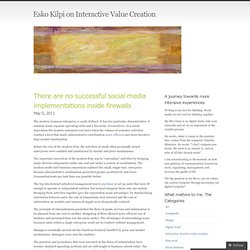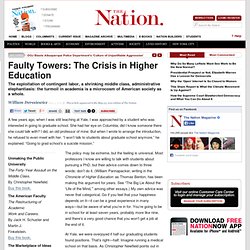

There are no successful social media implementations inside firewalls. There are no successful social media implementations inside firewalls May 5, 2011 The modern business enterprise is easily defined.

It has two particular characteristics: it contains many separate operating units and a hierarchy of executives. As a social innovation the modern enterprise was born when the volume of economic activities reached a level that made administrative coordination more efficient and more lucrative than market coordination. Before the rise of the modern firm, the activities of small, often personally owned enterprises were enabled and constrained by market and price mechanisms. The important innovation of the modern firm was to “internalize” activities by bringing many discrete components under one roof and under a system of coordination.
The big idea behind industrial management was to purchase or set up units that were fit enough to operate as independent entities, but instead integrate them into one system. Facing a world that has changed. Shannon’s Law by Cory Doctorow. Please enjoy Cory Doctorow’s short story “Shannon’s Law,” featured in the anthology Welcome to Bordertown, out May 24th from Random House.

For an introduction to the world of Bordertown, click here. When the Way to Bordertown closed, I was only four years old, and I was more interested in peeling the skin off my Tickle Me Elmo to expose the robot lurking inside his furry pelt than I was in networking or even plumbing the unknowable mysteries of Elfland. But a lot can change in thirteen years. When the Way opened again, the day I turned seventeen, I didn’t hesitate. I packed everything I could carry—every scratched phone, every half-assembled laptop, every stick of memory, and every Game Boy I could fit in a duffel bag.
Land rushes. I was too young for the Internet land rush. I’ll let you in on a secret, something you will never find out by reading the official sales literature of the Bordertown Inter-Networkers Governance Organization: It was never about wiring up B-town. “Shannon! Faulty Towers: The Crisis in Higher Education. The exploitation of contingent labor, a shrinking middle class, administrative elephantiasis: the turmoil in academia is a microcosm of American society as a whole.

A few years ago, when I was still teaching at Yale, I was approached by a student who was interested in going to graduate school. She had her eye on Columbia; did I know someone there she could talk with? I did, an old professor of mine. But when I wrote to arrange the introduction, he refused to even meet with her. “I won’t talk to students about graduate school anymore,” he explained. Unmaking the Public University The Forty-Year Assault on the Middle Class. The American Faculty The Restructuring of Academic Work and Careers. The Marketplace of Ideas Reform and Resistance in the American University. Wannabe U Inside the Corporate University. Higher Education? Crisis on Campus A Bold Plan for Reforming Our Colleges and Universities.
No University Is an Island Saving Academic Freedom. About the Author William Deresiewicz. ZERO ANTHROPOLOGY. Star's Reach. Books news, reviews and author interviews. The Information: A History, a Theory, a Flood by James Gleick – review. Too much information: the complaint du jour, but also toujours.

Alexander Pope quipped that the printing press, "a scourge for the sins of the learned", would lead to "a deluge of Authors [that] covered the land". Robert Burton, the Oxford anatomist of melancholy, confessed in 1621 that he was drowning in books, pamphlets, news and opinions. Thinking the Impossible: French Philosophy Since 1960 by Gary Gutting – review. Are the theory wars over?

Twenty-five years ago you couldn't cocoa your cappuccino without someone accusing you of floating a signifier, much less close down the, ahem, discourse with a simple "I prefer my coffee that way". Who is this mythic "I", the theorists wanted to know, and how could he presume to know what he prefers? Has he forgotten he's as fictional as Oliver Twist or Mrs Dalloway? Doesn't he know that his likes and dislikes are as ideologically determined as the medium-term financial strategy? College life these days looks rather less fraught. Which doesn't mean there was nothing to theory. What did they get from their studies? Money flowing into "open courseware" on college campuses. With an infusion of money from US stimulus spending, groups like The Gates Foundation, and the private sector, the technological landscape in higher education is changing rapidly.

In the recent past, classroom tech extended to YouTube videos, bare-bones online courses, or collaborative systems like Moodle; now, the emphasis is all about open courseware and analytics to monitor student behavior. Major bets that institutions are placing on technology in higher education were unveiled recently through a round of grants funded primarily by The Gates Foundation and led by Educause, a nonprofit association that encourages technology in education. In the first of two rounds, The Next Generation Learning Challenges (NGLC) awarded $10.6 million to 29 organizations, with the potential for an additional $5.4 million to be doled out later. Close to half of the initial $10.6 million went to open courseware projects that seek to publish adaptable Web-based courses for the public.
Free Download eBook John Sterman Business Dynamics Download PDF. JWSR Journal of World-Systems Research (JWSR) Mankiw - Books for 2010 Freshman Seminar.